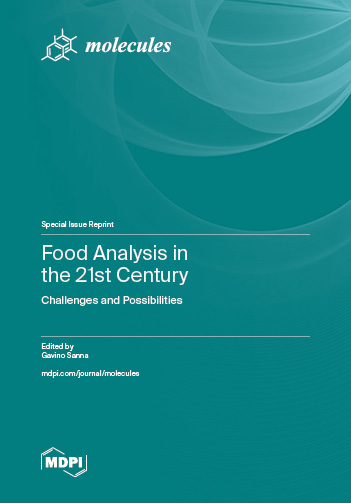Food Analysis in the 21st Century: Challenges and Possibilities
A special issue of Molecules (ISSN 1420-3049). This special issue belongs to the section "Analytical Chemistry".
Deadline for manuscript submissions: closed (31 July 2023) | Viewed by 16684
Special Issue Editor
Interests: analytical chemistry; validation of analytical methods; chemometrics and data analysis; environmental chemistry and monitoring; food chemistry and analysis; speciation analysis; science of materials; electroanalytical methods; sensors and biosensors; modification of electrode surfaces; gas-chromatography; liquid chromatography; hyphenated methods; ICP-MS methods; FT-IR methods; determination of trace analytes in foods; food georeferencing and traceability; bioaccumulation of toxic elements in cereals; synthesis and characterization of conductive polymers; biomedical analysis in dental research; studies of equilibria in solution between metal ions and ligands of biological interest; ability of vegetal biomasses in removal of organic pollutants by wastewaters
Special Issues, Collections and Topics in MDPI journals
Special Issue Information
Dear Colleagues,
In the globalized world of the 21st century, consumers have definitively lost touch with food producers. On the other hand, the increasing phenomenon of food being contaminated with old and new pollutants is generating strong alarmism among consumers, who are increasingly aware of this risk. As a result, the role of chemical analysis in food production is growing in importance. The growing interest of consumers, the food industry, governments and supranational organizations in food quality and safety enhances the importance of analyses that determine the composition and specific characteristics of the product. For this reason, today more than ever, food chemistry plays a crucial role in enabling scientists and food technologists to optimally manage the quality and safety of their products. Decision making based on analytical data provides guarantees to consumers only if the data are reliable, and this is only possible if analysis is carried out correctly at all stages. For these reasons, not only is the analytic phase, in the strict sense, of decisive importance to obtain reliable data but also the sampling and pretreatment phase and the interpretation of results.
The main objective of this Special Issue is to enable analytical chemists and food science and technology specialists to present original papers (research papers, reviews, and technical notes) on new methods and/or analytical techniques for determining the majority, minority, and trace constituents (or xenobiotics) in foods. Contributions related to the application of new food pretreatment techniques and those aimed at maximizing analytical information by means of chemometric techniques are encouraged. Original contributions aimed at the identification and/or speciation of emerging pollutants in food matrices or chemical objectification of the characteristics of quality and/or origin of foods are also encouraged, while studies related to the application of routine analytical methods on well-known food matrices are not considered within the scope of this Special Issue.
Dr. Gavino Sanna
Guest Editor
Manuscript Submission Information
Manuscripts should be submitted online at www.mdpi.com by registering and logging in to this website. Once you are registered, click here to go to the submission form. Manuscripts can be submitted until the deadline. All submissions that pass pre-check are peer-reviewed. Accepted papers will be published continuously in the journal (as soon as accepted) and will be listed together on the special issue website. Research articles, review articles as well as short communications are invited. For planned papers, a title and short abstract (about 100 words) can be sent to the Editorial Office for announcement on this website.
Submitted manuscripts should not have been published previously, nor be under consideration for publication elsewhere (except conference proceedings papers). All manuscripts are thoroughly refereed through a single-blind peer-review process. A guide for authors and other relevant information for submission of manuscripts is available on the Instructions for Authors page. Molecules is an international peer-reviewed open access semimonthly journal published by MDPI.
Please visit the Instructions for Authors page before submitting a manuscript. The Article Processing Charge (APC) for publication in this open access journal is 2700 CHF (Swiss Francs). Submitted papers should be well formatted and use good English. Authors may use MDPI's English editing service prior to publication or during author revisions.
Keywords
- foods
- analysis
- sampling pre-treatment
- chemometrics, quality
- origin
- xenobiotics
- food safety







